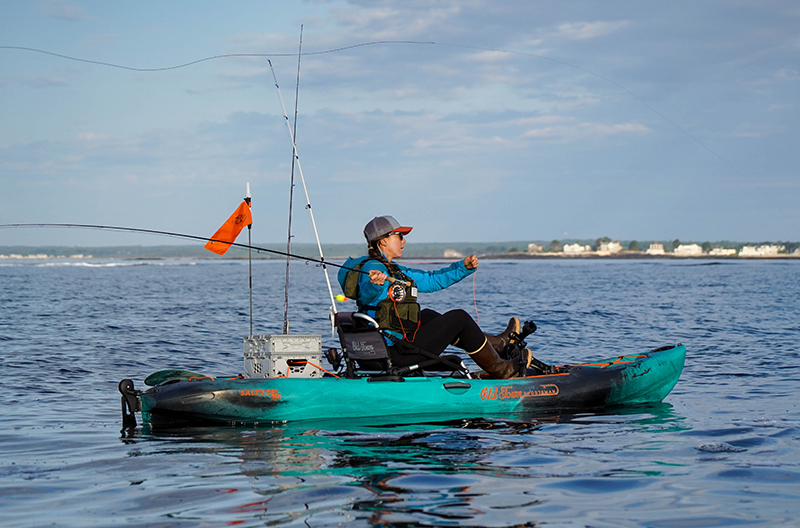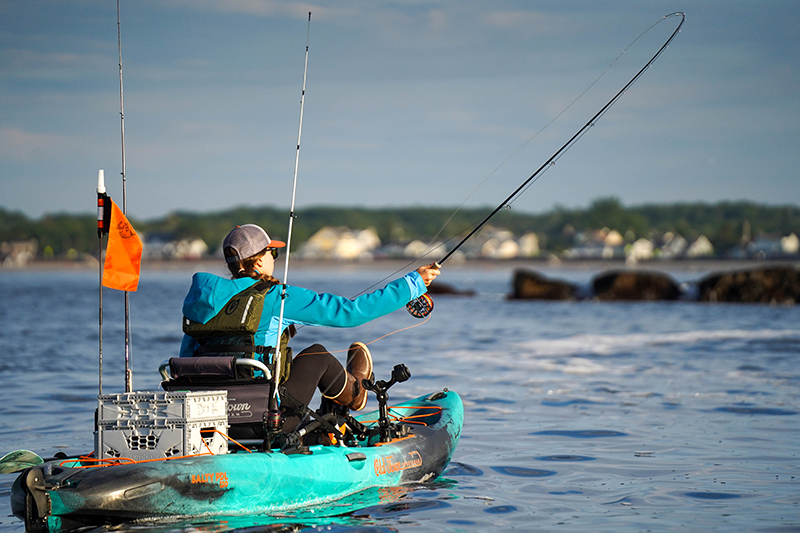A Guide to Kayak Fly Fishing for Striped Bass
By: Christi Holmes, Pro Staff
The striped bass is the king of saltwater recreational fishing in the Northeast. Stripers can grow large and put on a challenging fight when you hook one, making them one of the best recreational saltwater fish to catch. And since they swim close to shore, they are accessible for anyone, whether you own a boat or not. Although there are several ways to target striped bass, my preferred method is to chase them from my Old Town Sportsman Salty PDL kayak with a fly rod.
In New England, as inland waters warm up and trout and other coldwater species are not as active, I take my fly rod and kayak and head to the coast. I catch half as many schoolies on my fly rod on some outings than my friends using spinning gear, but other times, the fish prefer the natural look of feathers, and flies are all they seem to take.
I enjoy fly fishing for stripers. Catching stripers on a fly rod is worth the challenge. Every fish feels twice as large as it would on a conventional spinning rod. So whether you're a fly angler ready to make the switch to salt water or a striped bass angler looking for a challenge, once you catch your first striper on a fly rod, you'll be hooked.

KAYAK FLY FISHING GEAR FOR STRIPERS
I recommend an 8-10 weight fly rod. It allows you to cast heavy flies into the wind. Select a weight-forward fly line that matches your rod. If you do a lot of fishing in shallow flats, choose a floating fly line. Otherwise, an intermediate sinking line is a great all-around fly line. I like to use a 20lb 9-foot fluorocarbon leader.
TOP FLIES FOR STRIPERS FROM A KAYAK
The two most popular flies for striped bass fishing is chartreuse and white clouser minnow fly and a deceiver fly. Be sure to match the flies to the approximate size of your local baitfish (2"-5") to deceive the fish.
New saltwater fly anglers should practice fishing and casting from shore, familiarizing themselves with their gear and casting in windy conditions. In addition, I recommend learning the double-haul (a technique where the angler pulls on the backcast and the forward cast) as it is a critical skill that helps to cast flies further - crucial for saltwater fly anglers.

STRATEGY FOR STRIPERS ON A KAYAK
Much like you would from a boat, search for tell-tale signs of baitfish activity: diving birds or simmering water. If you spot either, hustle over to that area, careful not to run through the action. Cast into the baitfish, let the line sink for a second, strip the fly with quick short pulls, and be ready for the hit! Stripers are anything except predictable, so try varying the speed of your retrieve. I like to pause occasionally to imitate an injured baitfish. Once you feel a hit, strip set to set the hook, keep tension on the line and strip the fish in without the reel. If it's a larger fish, you can use your reel, but always keep tension on the fish.
If you don't see the apparent baitfish indicators, target the mouths of tidal rivers, areas with steep depth changes, or rip lines. Using your PDL or motorized kayak to fish these areas provides you a distinct advantage since shore anglers, and even boat anglers cannot reach some of these areas. In addition, a kayak is stealthier than a boat. It offers the ability to target shallower areas, further up rivers, under bridges at high tide, and closer to a rocky shoreline - places that are harder, unsafe, or impossible to reach with a boat or from shore.
Try blind casts into the rocks while drifting with the tidal current or wind, and try trolling a fly while searching for fish.
Safety is paramount when ocean fishing. As a saltwater angler, you're dealing with cold water, wind, and swell. Depending on where they are biting, you could be far from shore. Always wear your life jacket and follow the US Coast Guards safety regulations when fishing on the ocean.
Since fly casting requires more movement to cast and retrieve than a conventional rod and reel, you must be cautious and comfortable with casting. Unless it is a calm day, stay seated while you cast. I've found that staying seated and keeping my feet on the pedals prevents the line from getting tangled around the pedals. Some anglers prefer to wear a striping basket - it's all preference that requires some experience and experimentation to find what works best for you.
If the conditions allow and you're comfortable, try standing up and casting.
Finally, if you are new to fly fishing for striped bass, consider hiring a local guide specializing in fly fishing. Fishing with a guide can significantly reduce your learning curve while improving your experience.
See you on the water!







